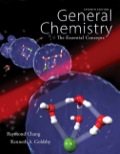
Concept explainers
Interpretation:
The partial pressures of the given gases have to be calculated.
Concept Introduction:
A mole fraction is the unit less proportion of the number of moles of a mixture constituent and the total number of moles in the mixture.
The number of molecules of gases is known. Since the mole fraction is:
- In a mixture of gases, every gas has an incomplete pressure which is the theoretical stress of that gas if it alone engaged the entire volume of the original combination at the same temperature.
- The sum pressure of an ideal gas mixture is the amount of the partial pressures of the gases in the mixture.
Answer to Problem 5.57QP
The partial pressure of
The partial pressure of
The partial pressure of
Explanation of Solution
First, we calculate the mole fraction Methane from the mixture. Then, we can calculate the partial pressure of each component.
The number of moles of the combined gases is:
The partial pressure of
Second, we calculate the mole fraction Ethane from the mixture. Then, we can calculate the partial pressure of each component.
The number of moles of the combined gases is:
The partial pressure of
Third, we calculate the mole fraction Propane from the mixture. Then, we can calculate the partial pressure of each component.
The number of moles of the combined gases is:
The partial pressure of
The partial pressures of the given gases were calculated.
Want to see more full solutions like this?
Chapter 5 Solutions
EBK GENERAL CHEMISTRY: THE ESSENTIAL CO
- what is the skeletal structure of a tertiary alkyl fluoride with six carbon atoms and no rings.arrow_forwardOne step of glycolysis is a retro-aldol reaction (aldolase) to produce ATP.Below is the aldol reaction of the equilibrium. Show the mechanism for the base catalyzed reaction. *see imagearrow_forwardProvide the missing information. *see imagearrow_forward
- Provide the missing information. *see imagearrow_forwardProvide the missing information. *see imagearrow_forwardDraw the mechanism (including all curved arrows for electron movement) showing how the maleicanhydride is attacked by the anthracene and formation of the final Diels Alder product.arrow_forward
 ChemistryChemistryISBN:9781305957404Author:Steven S. Zumdahl, Susan A. Zumdahl, Donald J. DeCostePublisher:Cengage Learning
ChemistryChemistryISBN:9781305957404Author:Steven S. Zumdahl, Susan A. Zumdahl, Donald J. DeCostePublisher:Cengage Learning ChemistryChemistryISBN:9781259911156Author:Raymond Chang Dr., Jason Overby ProfessorPublisher:McGraw-Hill Education
ChemistryChemistryISBN:9781259911156Author:Raymond Chang Dr., Jason Overby ProfessorPublisher:McGraw-Hill Education Principles of Instrumental AnalysisChemistryISBN:9781305577213Author:Douglas A. Skoog, F. James Holler, Stanley R. CrouchPublisher:Cengage Learning
Principles of Instrumental AnalysisChemistryISBN:9781305577213Author:Douglas A. Skoog, F. James Holler, Stanley R. CrouchPublisher:Cengage Learning Organic ChemistryChemistryISBN:9780078021558Author:Janice Gorzynski Smith Dr.Publisher:McGraw-Hill Education
Organic ChemistryChemistryISBN:9780078021558Author:Janice Gorzynski Smith Dr.Publisher:McGraw-Hill Education Chemistry: Principles and ReactionsChemistryISBN:9781305079373Author:William L. Masterton, Cecile N. HurleyPublisher:Cengage Learning
Chemistry: Principles and ReactionsChemistryISBN:9781305079373Author:William L. Masterton, Cecile N. HurleyPublisher:Cengage Learning Elementary Principles of Chemical Processes, Bind...ChemistryISBN:9781118431221Author:Richard M. Felder, Ronald W. Rousseau, Lisa G. BullardPublisher:WILEY
Elementary Principles of Chemical Processes, Bind...ChemistryISBN:9781118431221Author:Richard M. Felder, Ronald W. Rousseau, Lisa G. BullardPublisher:WILEY





